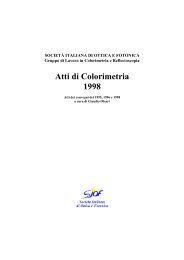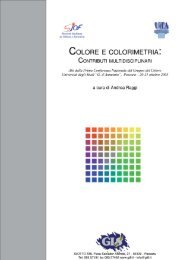Scarica gli atti - Gruppo del Colore
Scarica gli atti - Gruppo del Colore
Scarica gli atti - Gruppo del Colore
Create successful ePaper yourself
Turn your PDF publications into a flip-book with our unique Google optimized e-Paper software.
in standard and professional photography or a tunable filter are employed. A<br />
tunable filter has the ability to change its sensitivity to light by means of an<br />
internal magnetic field that can be controlled by the user [16-18], so that the same<br />
one filter may be used to replace a whole set of traditional filters. As the<br />
configuration of a tunable filter is tuned electronically in real time by the<br />
controlling computer, the acquisition with a tunable filter is therefore faster<br />
compared to traditional filters that are changed one time for each simulated sensor;<br />
also, operating a tunable filter does not imply more technical setup issues (if any)<br />
than those encountered using a filter wheel.<br />
For these reasons, we based our 'wide-band' acquisition system [2] on a VIS2<br />
VariSpec Tunable Filter (from Cambridge Research and Instrumentation); this<br />
filter has a nominal bandwidth of 40nm at 500 nm. The rest of the system consists<br />
of a Photometrics CoolSnap digital camera (from Roper Scientific) with a<br />
resolution of 1392 by 1040 pixels and a dynamic range of 12 bits, a high-quality<br />
28mm f/4 Rodagon lens (from Rodenstock), a cut-off optical filter for infrared and<br />
ultraviolet radiations (from Andover Corporation), and a set of light sources for<br />
professional photography (see Figures 1 and 2).<br />
Fig. 1 – A scheme of the wide-band multispectral acquisition system assembled by the<br />
authors<br />
To operate our system, we first performed a calibration phase in which we<br />
estimated the camera noise by means of acquisitions performed with the lens shut<br />
at different integration times. Based on the results of these trials, we built a<br />
correction mo<strong>del</strong> which is applied to raw acquired images in order to eliminate<br />
noise. We also verified the linearity of the camera sensors response, so that after<br />
noise correction we can apply Equation 5 to our system (barring a multiplying<br />
constant which is subsumed in the characterization mo<strong>del</strong> of equation 6) without<br />
30





